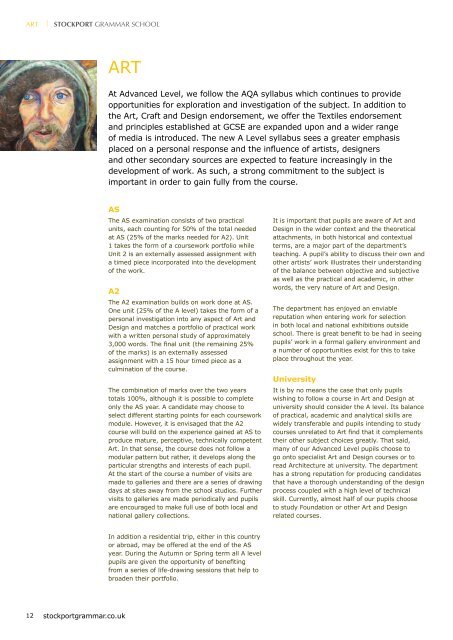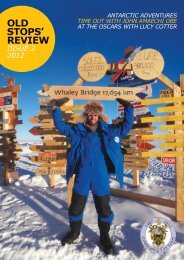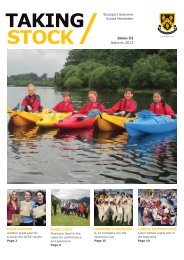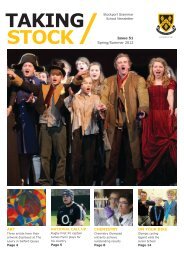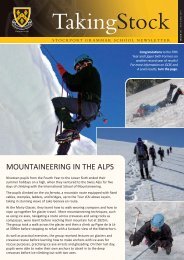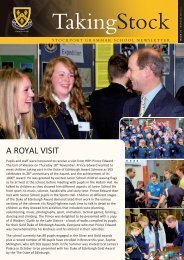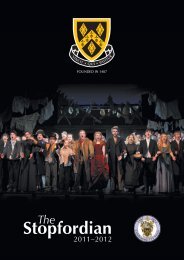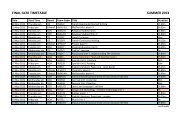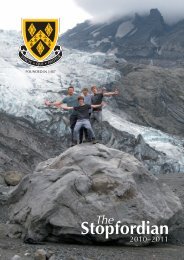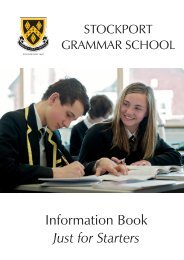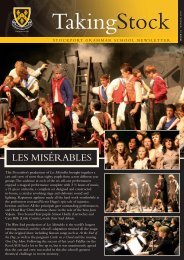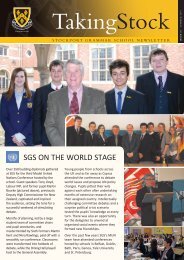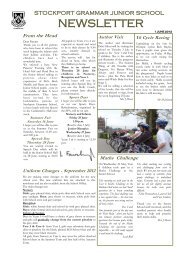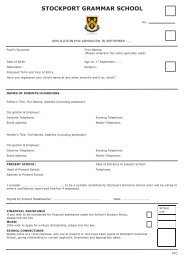Download the prospectus (pdf) - Stockport Grammar School
Download the prospectus (pdf) - Stockport Grammar School
Download the prospectus (pdf) - Stockport Grammar School
Create successful ePaper yourself
Turn your PDF publications into a flip-book with our unique Google optimized e-Paper software.
Art<br />
| STOCKPORT GRAMMAR SCHOOL<br />
STOCKPORT GRAMMAR SCHOOL | Biology<br />
Art<br />
At Advanced Level, we follow <strong>the</strong> AQA syllabus which continues to provide<br />
opportunities for exploration and investigation of <strong>the</strong> subject. In addition to<br />
<strong>the</strong> Art, Craft and Design endorsement, we offer <strong>the</strong> Textiles endorsement<br />
and principles established at GCSE are expanded upon and a wider range<br />
of media is introduced. The new A Level syllabus sees a greater emphasis<br />
placed on a personal response and <strong>the</strong> influence of artists, designers<br />
and o<strong>the</strong>r secondary sources are expected to feature increasingly in <strong>the</strong><br />
development of work. As such, a strong commitment to <strong>the</strong> subject is<br />
important in order to gain fully from <strong>the</strong> course.<br />
Biology<br />
This course builds on concepts and skills developed at GCSE. It presents<br />
essential principles in <strong>the</strong> context of <strong>the</strong> plethora of daily news items that relate<br />
to biological phenomena. Headlines tell us that scientists are in dispute about<br />
<strong>the</strong> use of a combined MMR vaccine; that genetic engineering will increase crop<br />
yields and end malaria; and that human activities are altering our climate in<br />
irreversible ways. Becoming aware of basic biological principles enables pupils<br />
to engage with issues such as <strong>the</strong>se, making <strong>the</strong>m better informed citizens. In<br />
addition, pupils learn to understand how scientists interact with each o<strong>the</strong>r and<br />
with society regarding new discoveries and <strong>the</strong>ir potential uses.<br />
AS<br />
AS<br />
A2<br />
The AS examination consists of two practical<br />
units, each counting for 50% of <strong>the</strong> total needed<br />
at AS (25% of <strong>the</strong> marks needed for A2). Unit<br />
1 takes <strong>the</strong> form of a coursework portfolio while<br />
Unit 2 is an externally assessed assignment with<br />
a timed piece incorporated into <strong>the</strong> development<br />
of <strong>the</strong> work.<br />
A2<br />
The A2 examination builds on work done at AS.<br />
One unit (25% of <strong>the</strong> A level) takes <strong>the</strong> form of a<br />
personal investigation into any aspect of Art and<br />
Design and matches a portfolio of practical work<br />
with a written personal study of approximately<br />
3,000 words. The final unit (<strong>the</strong> remaining 25%<br />
of <strong>the</strong> marks) is an externally assessed<br />
assignment with a 15 hour timed piece as a<br />
culmination of <strong>the</strong> course.<br />
The combination of marks over <strong>the</strong> two years<br />
totals 100%, although it is possible to complete<br />
only <strong>the</strong> AS year. A candidate may choose to<br />
select different starting points for each coursework<br />
module. However, it is envisaged that <strong>the</strong> A2<br />
course will build on <strong>the</strong> experience gained at AS to<br />
produce mature, perceptive, technically competent<br />
Art. In that sense, <strong>the</strong> course does not follow a<br />
modular pattern but ra<strong>the</strong>r, it develops along <strong>the</strong><br />
particular strengths and interests of each pupil.<br />
At <strong>the</strong> start of <strong>the</strong> course a number of visits are<br />
made to galleries and <strong>the</strong>re are a series of drawing<br />
days at sites away from <strong>the</strong> school studios. Fur<strong>the</strong>r<br />
visits to galleries are made periodically and pupils<br />
are encouraged to make full use of both local and<br />
national gallery collections.<br />
In addition a residential trip, ei<strong>the</strong>r in this country<br />
or abroad, may be offered at <strong>the</strong> end of <strong>the</strong> AS<br />
year. During <strong>the</strong> Autumn or Spring term all A level<br />
pupils are given <strong>the</strong> opportunity of benefiting<br />
from a series of life-drawing sessions that help to<br />
broaden <strong>the</strong>ir portfolio.<br />
It is important that pupils are aware of Art and<br />
Design in <strong>the</strong> wider context and <strong>the</strong> <strong>the</strong>oretical<br />
attachments, in both historical and contextual<br />
terms, are a major part of <strong>the</strong> department’s<br />
teaching. A pupil’s ability to discuss <strong>the</strong>ir own and<br />
o<strong>the</strong>r artists’ work illustrates <strong>the</strong>ir understanding<br />
of <strong>the</strong> balance between objective and subjective<br />
as well as <strong>the</strong> practical and academic, in o<strong>the</strong>r<br />
words, <strong>the</strong> very nature of Art and Design.<br />
The department has enjoyed an enviable<br />
reputation when entering work for selection<br />
in both local and national exhibitions outside<br />
school. There is great benefit to be had in seeing<br />
pupils’ work in a formal gallery environment and<br />
a number of opportunities exist for this to take<br />
place throughout <strong>the</strong> year.<br />
University<br />
It is by no means <strong>the</strong> case that only pupils<br />
wishing to follow a course in Art and Design at<br />
university should consider <strong>the</strong> A level. Its balance<br />
of practical, academic and analytical skills are<br />
widely transferable and pupils intending to study<br />
courses unrelated to Art find that it complements<br />
<strong>the</strong>ir o<strong>the</strong>r subject choices greatly. That said,<br />
many of our Advanced Level pupils choose to<br />
go onto specialist Art and Design courses or to<br />
read Architecture at university. The department<br />
has a strong reputation for producing candidates<br />
that have a thorough understanding of <strong>the</strong> design<br />
process coupled with a high level of technical<br />
skill. Currently, almost half of our pupils choose<br />
to study Foundation or o<strong>the</strong>r Art and Design<br />
related courses.<br />
Unit 1: Biology and Disease<br />
Pupils study various transport systems of <strong>the</strong><br />
body including those related to digestion and<br />
gas exchange, covering <strong>the</strong> role of enzymes<br />
as biological catalysts, and passive and active<br />
transport of substances across biological<br />
membranes. The systems may be affected by<br />
disease, but symptoms and data relating to risk<br />
factors can be explained. The blood’s defensive<br />
functions and drugs such as antibiotics help to<br />
limit <strong>the</strong> spread and effects of disease.<br />
Unit 2: The Variety of Life<br />
DNA is an information-carrying molecule:<br />
similarities and differences in <strong>the</strong> sequence of<br />
bases in DNA result in genetic diversity within<br />
species, such as differences in biochemical basis<br />
and cellular organisation. Size and metabolic<br />
rate affect <strong>the</strong> requirements of organisms,<br />
giving rise to adaptations such as specialised<br />
exchange surfaces and mass transport systems.<br />
Classification is a means of organising <strong>the</strong><br />
variety of life. Recent approaches to classification<br />
of species draw on wide evidence to clarify<br />
relationships between organisms.<br />
Unit 3: Investigative and Practical Skills<br />
Practical techniques: selecting appropriate<br />
qualitative and quantitative methods; making<br />
and communicating reliable observations and<br />
measurements; analysing and explaining<br />
methodology, results and impact of experiments.<br />
Candidates will be assessed on <strong>the</strong>ir understanding<br />
of investigative and practical skills in this unit<br />
and in Units 1 and 2. Opportunities to carry out<br />
practical work are provided in <strong>the</strong> context of<br />
material contained in Units 1 and 2.<br />
Unit 4: Populations and Environment<br />
Living organisms form structured communities<br />
within dynamic but essentially stable ecosystems<br />
through which energy is transferred and chemical<br />
elements are cycled. Humans are part of <strong>the</strong><br />
ecological balance and <strong>the</strong>ir activities affect it<br />
both directly and indirectly. Sustainability of<br />
resources depends on effective management<br />
of <strong>the</strong> conflict between human needs and<br />
conservation. Fieldwork: Quantitative data to be<br />
collected from at least one habitat, elementary<br />
statistical analysis to be applied to <strong>the</strong> results.<br />
Unit 5: Control in Cells and in Organisms<br />
Multicellular organisms are able to control <strong>the</strong><br />
activities of different tissues and organs within<br />
<strong>the</strong>ir bodies. They do this by detecting stimuli<br />
and stimulating appropriate effectors and <strong>the</strong>reby<br />
increasing <strong>the</strong>ir chances of survival. Cells are<br />
also able to control <strong>the</strong>ir metabolic activities<br />
by regulating <strong>the</strong> transcription and translation<br />
of <strong>the</strong>ir genome. In multicellular organisms,<br />
this control of translation enables cells to have<br />
specialised functions, forming tissues and organs.<br />
The sequencing and manipulation of DNA has<br />
many medical and technological applications.<br />
Pupils gain an appreciation of common<br />
ailments resulting from a breakdown of control<br />
mechanisms and <strong>the</strong> use of DNA technology in<br />
<strong>the</strong> diagnosis and treatment of human diseases.<br />
Unit 6: Investigative and Practical Skills<br />
Unit 6 covers similar ground to Unit 3, although<br />
work at A2 Level seeks to reach a higher standard<br />
than AS. Candidates will be assessed on <strong>the</strong>ir<br />
understanding of investigative and practical skills<br />
in this unit and in Units 4 and 5. There are two<br />
parts to practical assessment: <strong>the</strong> Practical<br />
Skills Assessment involves assessment by<br />
<strong>the</strong> teacher throughout <strong>the</strong> course; and <strong>the</strong><br />
Investigative Skills Assignment is a timetabled<br />
assessment set by <strong>the</strong> exam board and marked<br />
to <strong>the</strong>ir guidelines.<br />
12 stockportgrammar.co.uk stockportgrammar.co.uk 13


